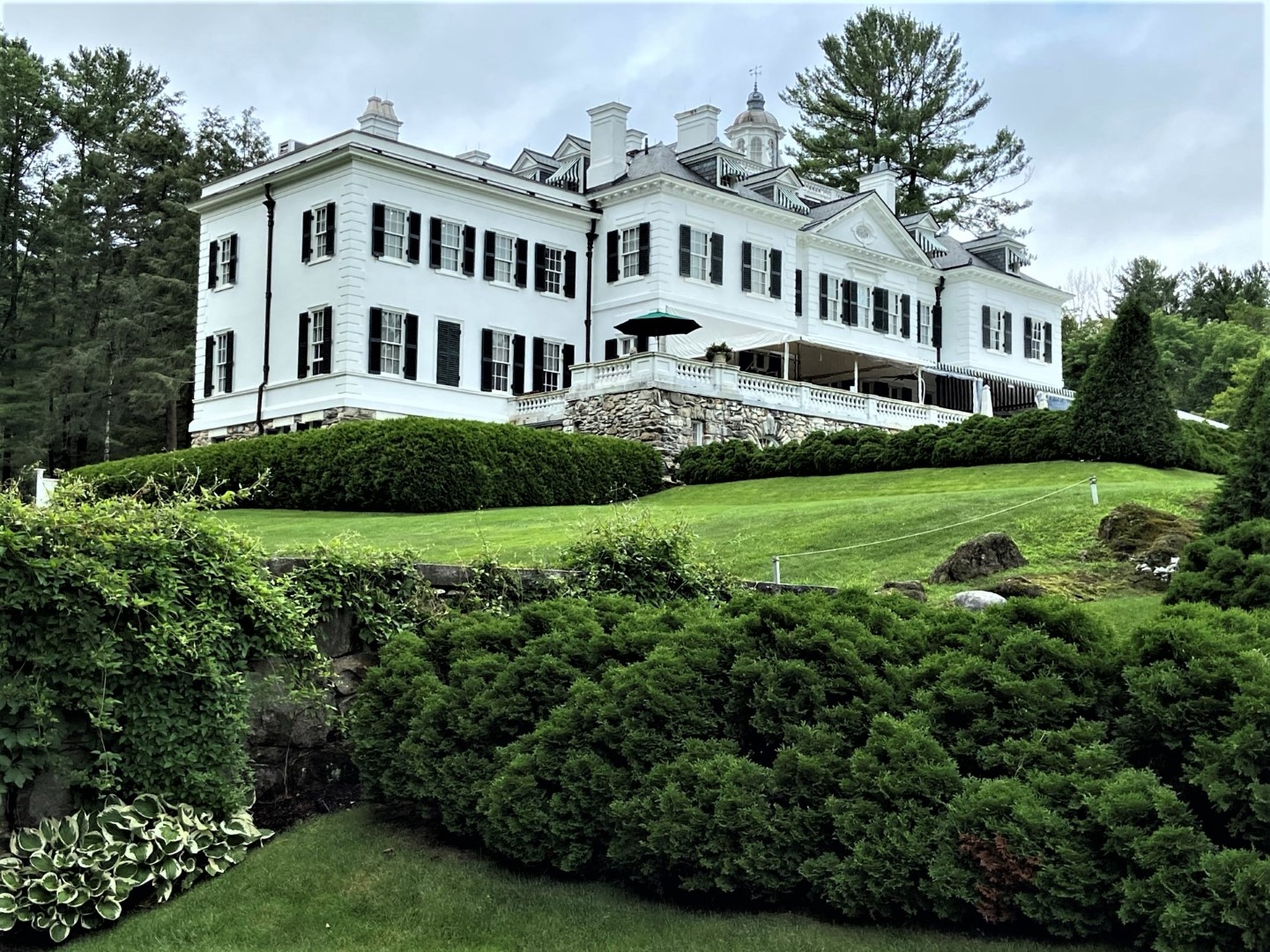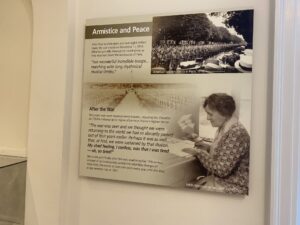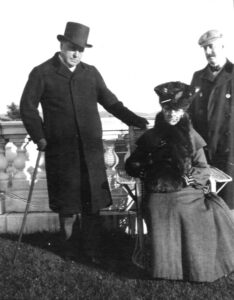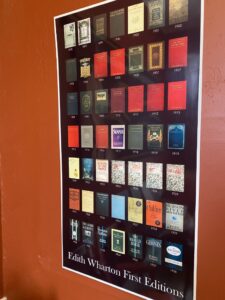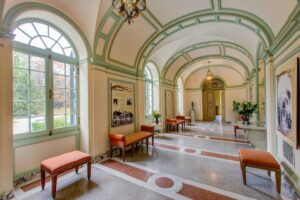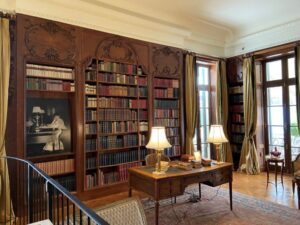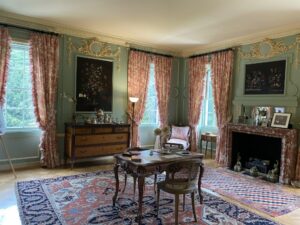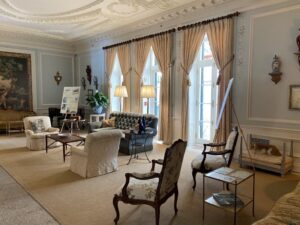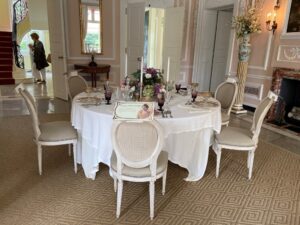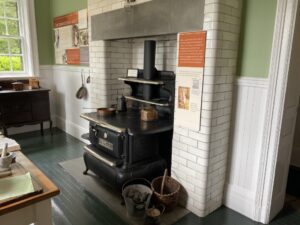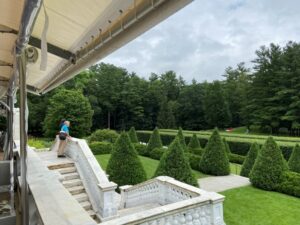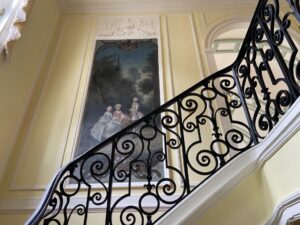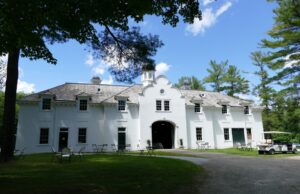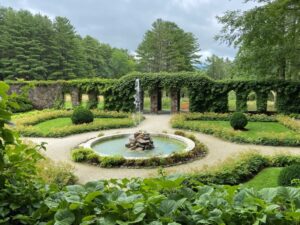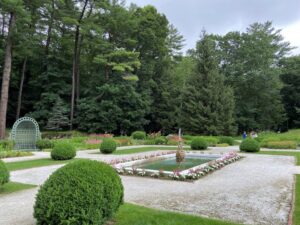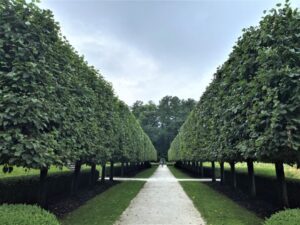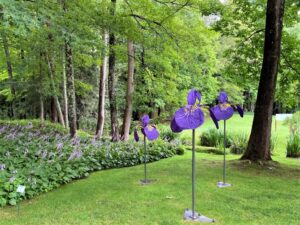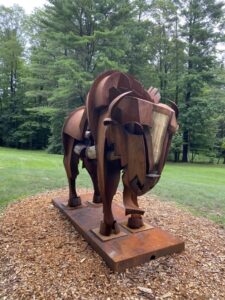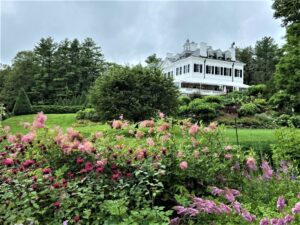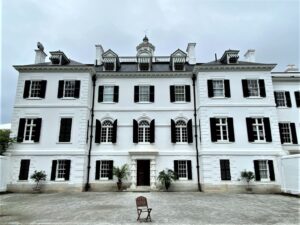Nestled in gardens in the Berkshires town of Lenox, writer Edith Wharton’s country home, The Mount, serves as both a historic site and a cultural center for the local community and everyone who visits this beautiful part of Massachusetts. A sharp-eyed chronicler and critic of America’s Gilded Age, Wharton won a Pulitzer Prize in 1921 for her novel The Age of Innocence, becoming the first woman to earn this honor. The Mount preserves the writer’s legacy in exhibits and also displays another side of Wharton’s talents. Her books about interior design and gardens were famous, and she lovingly embodied her ideas in designing The Mount. The inspiration Wharton felt here can be shared by those who visit and participate in the cultural programming that is now part of The Mount’s mission. One major event this summer through mid-October 13 is local arts organization SculptureNow’s annual sculpture exhibition.
The Mount’s History
Looking at the well-preserved mansion, it’s easy to image that The Mount, one of only 5 percent of National Historic Landmarks dedicated to women, has always been cared for. Its history, though, has twists and turns rivaling those in Wharton’s novels. Edith Jones Wharton (1862–1937) was born into upper-class New York society and was interested in writing from an early age. She benefited from affluence, though she chafed at society’s restrictions. After marrying Teddy Wharton in 1885, she lived in New York City and Newport, but she disliked Newport and bought land in the Berkshires, another area that attracted wealthy vacationers. Working with architects Francis Hoppin and Ogden Codman Jr. (with whom she had written The Decoration of Houses in 1897), Wharton designed the classically inspired house with its Italian and French influences. She also helped design the gardens.
The Whartons moved into the house in 1902 and stayed until 1911. Although Edith Wharton’s creativity flourished and she wrote The House of Mirth and Ethan Frome here, among other works, her marriage deteriorated. The couple sold the property and divorced in 1913, and Wharton spent the rest of her life in France, a country she loved. The Mount later became home to the Foxhollow School and then the theatre group Shakespeare & Company (from 1978 to 2001), but its buildings deteriorated; the acreage was reduced from 128 to 49 acres. Local residents and other people with ties to the property began a campaign to raise money to save The Mount. After the property reopened to the public in 2002, it faced challenges, including possible foreclosure in 2008. Since 2010, the expansion of the site’s role as a cultural center has enabled The Mount to carry its legacy into the future.
Exploring The Mount
A good place to start a visit is at the Stable, a large building that held Wharton’s carriages and motorcars. It shows an engaging introductory film about Wharton and is the site of many cultural programs. Visitors can explore the Main House on a guided or self-guided tour (periodic evening ghost tours are another option), and lively exhibits in the rooms do a good job interpreting aspects of the house and Wharton’s complicated personal life and career. Notable throughout are the airy, bright rooms. Wharton rejected the dark wood and clutter of decorative objects favored in grand houses of the time, favoring white-painted moldings, light colors, and symmetrical rooms.
The furniture and furnishings in the house are not Wharton’s, though some pieces are similar to styles she favored. One benefit of this is that the velvet ropes have come down, allowing people to walk freely and look out the windows to the gardens and woodlands. An exception is the wood-paneled library, a book lover’s paradise holding the writer’s original 2,700-book library. The Drawing Room, used for sitting after dinner, has magnificently restored plaster ceilings, and the Dining Room includes a round table, which Wharton preferred to facilitate conversation with visiting friends like Henry James. Wharton’s Boudoir served as a private space for writing letters, but her creative writing was done mostly in her bed in the morning.
The Mount also has exhibits about daily life at The Mount and Wharton’s world after she left the house. An entire wing, including a sewing room, linen closet, scullery, and kitchen, was used by some of the 20 people who worked here; women staff lived upstairs. Another exhibit examines Wharton’s less-recognized role in France during World War I. She stayed in Paris and worked for the French war effort, founding and aiding charitable efforts for refugees and the unemployed. Wharton even visited the front lines and wrote articles about it. For her humanitarian efforts, she was named a Chevalier of the Legion of Honor, France’s highest award.
Gardens and Landscape
The house and lovely Gardens at the Mount form the harmonious whole that Wharton favored, with outdoor garden “rooms” near the house and viewable from its broad terrace, and the natural landscape beyond. The splashing fountain and greenery in the sunken Italian Garden create a peaceful, private space. The French Flower Garden is more formal, full of color from the phlox, hydrangeas, and other plants and shrubs the writer favored. Around the property, four short woodland trails invite exploration.
Community and Culture
To encourage locals and visitors to enjoy the landscape Wharton found so restorative, The Mount opens its gardens and grounds to the public for free dawn through dusk daily. In addition, young people 18 and under have free admission to the house. Programs on the grounds have included yoga classes with Lenox Yoga and free bird walks with the Massachusetts Audubon Society.
The Berkshires is home to many arts organizations and venues such as Tanglewood, the summer home of the Boston Symphony Orchestra. Since 2010, The Mount has added a role that expands its audience and fits well with the region, evolving from a traditional house museum to a year-round cultural center. Besides its own programming, including a Writers-in-Residence program, readings (many by emerging women writers), and talks, The Mount partners with dozens of community organizations. One example is the stunning SculptureNow exhibition and sale (June 1 through October 13), an annual event with 30 new sculptures sited on the grounds. Proceeds benefit the artists, the local SculptureNow educational nonprofit organization, and The Mount. Self-guided (labels have QR codes) and artist-led tours (highly recommended) are popular.
WordXWord is a free three-day festival of storytelling and poetry at The Mount that celebrates diverse voices in the spoken word. As part of its music offerings, The Mount is presenting a new series of Thursday evening outdoor jazz concerts in August, called Concerts in the Dell. The Mount also partners with Berkshire Pulse, a nonprofit performing arts school, to present dance classes and performances. Begun in 2020, the NightWood immersive sound-and-light experience, presented from November into January, reveals The Mount’s architecture and landscape in imaginative ways. The online calendar has full details for in-person and online programs for all ages.
All this means that a visit to The Mount can be doubly magical: exploring the world of a famous writer and engaging in a lively cultural experience.
Side Dish
Lenox offers ample dining options, but for the full Wharton experience, visitors can settle in outside at The Mount’s seasonal Terrace Café and enjoy the garden views. The menu lists salads, classic sandwiches such as Black Forest ham, and a fruit and cheese plate. Save room for local-favorite SoCo ice cream from Great Barrington.
Linda Cabasin is a travel editor and writer who covered the globe at Fodor’s before taking up the freelance life. She’s a contributing editor at Fathom. Follow her on Instagram and Twitter at @lcabasin.

